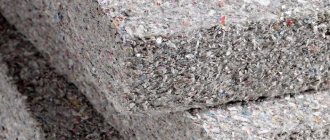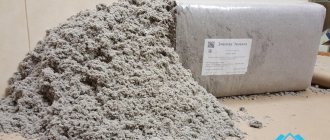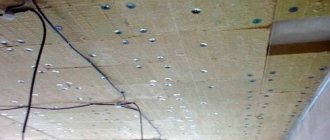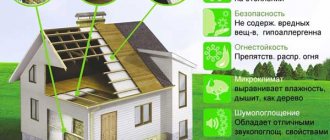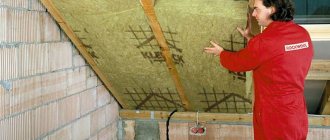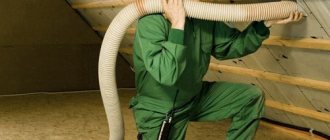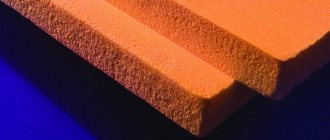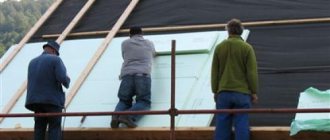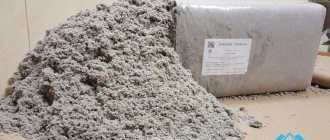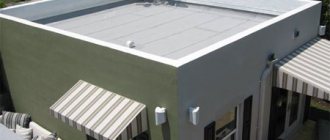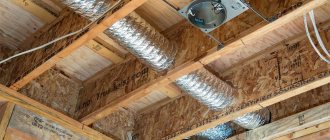An additional attic floor can serve as a living space if it is properly insulated. Construction stores offer several options for insulation for walls, floors, ceilings and roofs. They differ from each other in thermal insulation qualities, price, installation method and other characteristics.
Insulation with ecowool is not only thermal insulation and reliable noise insulation, but also a good way to protect your home from rot, rodents and prevent the formation of condensation.
Many people choose to insulate their attic with ecowool because of its low cost, positive characteristics and properties that distinguish this material from other similar ones.
It is not difficult to install ecowool yourself. This does not require special skills in construction work. You will need a special installation - blowing equipment to make insulation. It must be remembered that this thermal insulation is capable of expanding, so its volume will be greater than in packaged form. Builders advise applying a layer 15-20 cm thick, which will provide adequate protection against heat loss in the attic.
Characteristics of the ecowool material, its advantages and disadvantages
Ecowool is a cellulose insulation material that consists of 80% recycled newspaper paper, 12% boric acid (an antiseptic), and 8% fire retardants and lignin (an adhesive). All components that provide insulation of the building are absolutely harmless to humans, non-toxic natural substances.
Advantages of cellulose insulation over other types of thermal insulation:
Attic insulation scheme - 1) roofing. 2) vapor barrier film. 3) ecowool. 4) wooden logs and lathing.
- No seams. The ability to make an even layer without voids, which will fill the surface of any complex structure with insulation. Can be used for roofing.
- It does not shrink in a vertical position due to its elasticity and resilience, which is important for the attic.
- Corrosion does not form upon contact with metal surfaces.
- Low breathability. Low level of heat transfer due to wood fibers having a capillary structure.
- Thermal insulation properties are at the level of the best types of insulation.
- Moisture-resistant insulation without the need to additionally use a vapor barrier. Moisture circulates freely inside the cellulose fibers and evaporates without stagnating inside.
- Good sound insulation. Covering the roof with a layer of ecowool makes it possible not to hear the sound of drops when it rains. After all, a layer of only 50 mm of ecowool provides noise insulation of 63 dB, while 100 mm of mineral wool provides only 37 dB.
- Fire safety - the material in question does not burn, but smolders. Has flammability group G2: prevents the spread of flame.
- Resistant to the spread of microorganisms and fungi, not subject to rotting or destruction. The service life of ecowool is 50-80 years.
- Due to the free-flowing consistency of the material, there are no scraps - waste-free production.
Insulation scheme using the wet-glue method - 1) wooden logs. 2) ecowool. 3) brick wall.
The disadvantages of using ecowool for the attic and other rooms include the following indicators:
- Installation of “floating” floors is impossible due to the low density of the cellulose compound.
- The dry method of laying ecowool produces a lot of dust.
- Special equipment is required, without which it is impossible to cover uneven surfaces with ecowool.
When laying ecowool manually, voids may form. It is very important to maintain a certain density of the material. For walls - this is 66-70 kg/m³, for floors - 35-40 kg/m³.
Physico-chemical and mechanical characteristics of the material
The main indicators of ecowool include:
- thermal conductivity coefficient - from 0.032 to 0.042 W/m*K;
- compressibility - up to 25%;
- vapor permeability - not less than 0.3 mg/m*h*Pa;
- humidity by weight - up to 1%;
- flammability group - G1, G2;
- water absorption by volume - up to 1%;
- density - from 25 to 80 kg/cubic. m;
- operation is possible at temperatures from −60 to +230 degrees;
- the ability to absorb sound up to 60 dB (versus 48 for mineral wool).
There are no uniform parameters regarding cost. Cellulose insulation is available at low prices (25-50 rubles per cubic meter), but extra-class materials can cost the consumer 20 times more. Domestic analogs are much cheaper than foreign ones, but the characteristics are almost the same.
Methods for insulating the attic floor with ecowool
Providing thermal insulation of the attic with environmentally friendly ecowool will turn an additional floor in the house into a full-fledged living space. The walls, floors, ceiling and roof must be laid with a layer of thermal insulation. After all, insulating an attic with ecowool can help not only absorb noise from rain, but also reduce overheating of the roof on hot days.
Scheme of insulation of internal partitions - 1) laminate. 2) GVL. 3) ecowool. 4) Reinforced concrete slab. 5) wooden log.
There are three ways to apply cellulose insulation to horizontal and vertical surfaces:
- wet method - the insulation is diluted with water or water with glue;
- dry application by hand or using a special blowing machine. This method is suitable for floors: floors, attic ceilings;
- combined application - wet layer plus dry.
To manually fill thermal insulation into ceilings and attic wall cavities, the contents of a bale of ecowool are poured into any suitable container: a barrel, a box, a bucket. Fluff the contents of the package in a compressed state using a drill with a nozzle for mixing paints. The material will increase in volume up to 3 times. Now you can perform insulation.
When working with ecowool, safety precautions must be observed; it is recommended to wear a protective mask.
Insulation is poured into the cavity and compacted to a density 2 times less than in the original packaging. This is done in order to avoid the appearance of voids, which will lead to freezing of the insulation. For a roof, the manual method of installing ecowool is not suitable. Before laying the insulation, the surfaces are cleaned, primed and dried. Finally, cover with boards until the surface dries.
To install the insulation manually, you will need the following tools:
- a container for stirring insulation of a suitable size;
- drill with a nozzle for mixing paint;
- a mop or other device for distributing insulation over the surface;
- boards for rough covering of ecowool layer on horizontal surfaces.
Ecowool insulation
How to insulate an attic with ecowool with your own hands?
To do this, according to the instructions, you need a special installation that shreds packs of ecowool and then blows its pieces between the cavities using a compressor. But, if there is no installation, then the packs are loosened with a drill with an attachment, and the cavities are filled and compacted manually. It is mandatory to comply with standards for the filling density of ecowool on different surfaces:
- For walls – within 45 kg/m3.
- For floors – up to 35 kg/m3.
Stages of wall insulation:
- From inside the living space, a vapor barrier membrane is installed on the rafters.
- On the outside there is a waterproofing film. These films are laid overlapping, carefully gluing the joints with tape.
- Ecowool is densely poured into the resulting cavities.
Characteristics of methods for installing ecowool using a blow molding installation
Diagram of a roof insulated with ecowool.
Using a blowing installation, horizontal and inclined surfaces, as well as closed cavities in walls, are insulated. The cavity can be enclosed not only with rigid materials, such as drywall. Membrane waterproofing or kraft paper will also work. A hole is made in the cavity, a blower hose is inserted into it and the space is filled with a mixture of ecowool and air. The air pulls particles of material with it, which tend to stick to all surfaces. This creates a dense insulation that can be used from floor to roof. There may be no limiters on the horizontal surfaces of the attic. The thermal insulation layer is laid down as an even carpet.
Ecowool moistened with water (wet installation method) is used for open vertical structures and inclined roof planes. The material is loaded into a special hole in the equipment, where it is automatically loosened. Wet ecowool is sprayed over the open surface of the wall between the frame structures. The material adheres to the surface, forming an even layer. Protruding layers of insulation are trimmed. The insulation layer becomes elastic, sticks to all surfaces, and is not damaged for many years.
The combined application of a coating for insulation is carried out in two stages: first, the layer is formed using a wet-adhesive method, then - dry. This method provides increased sound insulation and thermal insulation. It can be used for roofing.
From the above we can conclude that ecowool is a high-tech, durable, environmentally friendly material, easy to install. This is an indispensable insulation material for attics and other rooms with complex structures of walls, roofs and other surfaces.
Stages of insulating an attic from the inside
The process of insulating an attic takes place in several stages, in addition to choosing the material:
The procedure for insulating the attic
- Roof insulation;
- Insulation of walls;
- Floor insulation.
Roof insulation in the attic
First, it’s worth telling what the process of insulating an attic roof from the inside should consist of. Stages of work:
When insulating the attic, do not forget about steam and waterproofing
- Main roof covering;
- Waterproofing device;
- Laying thermal insulation;
- Vapor barrier;
- Finishing work.
The initial stage, after the existing main roof covering, is waterproofing, which is laid along the entire height of the supports, from the bottom to the very ridge of the roof. Before laying the material, all wooden roof elements are treated with an antiseptic. If there are rotten or moldy parts, they must be replaced. Knowing the coefficient of thermal conductivity, you should make a decision to eliminate possible heat loss, whether one layer of insulation will be enough or whether it is worth laying a second layer. In the place where the insulation is laid to ensure ventilation, when installing this material, a gap is left between it and the roof. If the roofing material is wave-shaped (tiles, metal tiles), then the layer is left at least 2.5 cm. And if the roof is made of flat-format material (steel sheets, rolled materials), the space between the insulation and the roof should be doubled.
Thermal insulation is carried out by laying the selected material on top of the waterproofing layer.
The next stage is vapor barrier. The material is a special film, which in appearance can be like a regular film, or can be in the form of a membrane, foil or perforated film. The film is attached to the rafters using a construction stapler.
Decoration of the premises. At this stage, the following occurs: fastening plastic, drywall, lining, moisture-resistant chipboard, fiberboard or plywood sheets. At the same time, it needs to be fastened close to the vapor barrier, or it can be mounted on a thin type sheathing made of individual slats. Then, if necessary and desired, you can paste wallpaper, varnish or paint.
Insulation of walls in the attic from the inside
Insulation of attic walls is carried out when the roof does not reach part of the floor. So, when insulating walls, you should go through several stages to achieve the final result:
Treating wood with antiseptic
- Treating walls with an antiseptic, removing dust and dirt;
- Sheathing the roof surface from the inside using beams or untreated boards;
- Waterproofing;
- Laying a layer of selected insulation;
- Vapor barrier layer;
- Wall decoration.
A distinctive feature of wall insulation work is the absence of sheathing, unlike the roof. The rest of the process follows the same method as insulating the attic roof.
After treating the walls with an antiseptic, a vertical frame is installed on the surface of the walls from timber or untreated boards. The beam is attached to the wall using metal corners or dowels.
Plasterboard finishing of an insulated attic
Waterproofing walls involves laying material into the cells of the frame. Afterwards, the first layer of the selected insulation is formed.
The vapor barrier layer is fixed on top of the first layer of insulation. The vapor barrier material is a film, as mentioned above, which should fit tightly, without any sagging.
Wall finishing is carried out using facing materials: OSB boards, plasterboard, which are attached to a frame made of metal profiles or wooden blocks.
Insulating the floor in the attic
Basically, the attic floor is made in the form of a wooden structure. And to create complete and final comfort in the room, the floor also needs to be insulated. And floor insulation also takes place in several stages:
- Removing old floor covering;
- Inspection of logs, detection of damage and defects, elimination of defects;
- Fixing the vapor barrier film;
- Laying the first layer of insulation;
- Laying the second layer of vapor barrier;
- Sheathing joists.
The design of the insulated attic floor
The vapor barrier film is installed along the entire length and width of the insulated surface. The film is secured with a construction stapler. In this case, the film must exactly follow all the lines of the joist system, closely adjacent to the beams.
The first layer of insulation must be laid between the joists. Next comes the stage of laying a vapor barrier layer, which will become the second layer. Accordingly, the vapor barrier material is laid on top of the insulation.
And the final stage will be facing the logs using front coverings made of OSB boards or wooden boards.
Where did ecowool come from and what is it even?
Ecowool has been known in the world for quite a long time as an insulation material, but in the vastness of our great homeland it began to be used only in the late nineties of the last century. Several countries are contesting the championship, but it is believed that the Finns were the first to come up with this material and begin to widely use it.
It is no secret that scientists around the world are constantly working on the problem of intelligent processing of secondary raw materials. So, ecowool is obtained by processing waste paper, as well as waste from the pulp, paper and woodworking industries.
Therefore, this material was originally called cellulose cotton wool insulation. And only then did cunning advertisers decide that ecowool would sound, and therefore sell, better.
The composition of this material includes about 81% cellulose, 12% boric acid, the remaining 7% is borax. The connection is quite justified; cellulose itself is a fibrous material, light and quite elastic, which causes the extremely low thermal conductivity of the insulation.
The fibrous structure of the material in comparison.
But cellulose in its pure form burns not much worse than gasoline, and to minimize this disadvantage, a fire retardant called borax is present. The fact is that at a temperature of 90ºC, borax helps to release natural moisture from cellulose fibers; in other words, cotton wool extinguishes itself.
And finally, boric acid is a powerful antiseptic. For example, a wooden house insulated in this way will no longer be attacked by rodents. Plus, the wood itself will not become covered with dark spots of mold and will last much longer.
Flammability test.
Ecowool is a fibrous, lightweight, free-flowing material, predominantly gray in color (with rare exceptions, it can be white). Unlike mineral and glass wool, which are already sold in mats and briquettes, this material is sold in bags, lightly compacted to a density of 110 kg/m³. When the bag is opened, the material is fluffed, after which its volume increases 3 to 4 times.
White material.
The average technical characteristics of this insulating material are shown in the table.
| Characteristic name | Numerical value or marking |
| The coefficient or level of thermal conductivity of ecowool | 0.037 – 0.042 W/mºK |
| Flammability level | Group “G2”, which means moderately flammable or smoldering according to GOST 30244 |
| Density of material after installation | Depending on the installation location, thickness and purpose of insulation, it can range from 26 to 95 kg/m³ |
| Vapor permeability level | About 0.3 mg/(mhPa) |
| Smoke generation level when exposed to open flame | According to GOST 12.1.044 corresponds to group “D2” (Moderate smoke generation) |
| Spread and intensification of an open flame through insulation |
What is ecowool
This insulation appeared in Europe a long time ago and has proven itself to have positive qualities. It appeared on our market not so long ago and is considered a fairly new source of insulation.
This thermal insulating material mainly consists of cellulose, it makes up 80%. The fibers of this substance retain heat quite firmly. At the same time, no seams are left during application. The use of cellulose alone is under no circumstances acceptable, not for insulation or for construction.
It is very flammable even under the influence of simple natural factors. To eliminate these factors and make the material better. Some additional ingredients have been added to its composition. Such as borax and boric acid.
Insulation composition:
| Components | Content | Component properties |
| Cellulose fiber | 80 % | Contains components reminiscent of newsprint. |
| Boric acid | 12 % | Protection from fungus, rot and rodents. |
| Borax | 8 % | Ecowool received fire safety class G2. |
Insulation installation options
Insulating a house with ecowool can be done in several different ways. I’ll say right away that home improvement with your own hands is possible, but the quality of such work will be an order of magnitude lower than using special equipment. And your professionalism has nothing to do with it, this is the specificity of the material.
Subtleties of self-insulation
As such, the instructions for arranging this type of insulation with your own hands are simply simple. There is really nothing to go into detail here.
You should uncork the bag, pour the required amount of material into a suitable container or directly onto the installation site and fluff the cotton wool using a construction mixer (you can use a mixing attachment on an electric drill). That's basically all the wisdom. It is much more important to understand in what cases it is worth doing this.
Fluffing the material with a construction mixer.
Most often, the attic of the roof and the floor of the house are insulated independently. But there are subtleties here. In both cases, the material is poured, fluffed up and lightly compacted between the lags, therefore, there must be a solid, and most importantly, dry base underneath.
The attic is simply ideal in this regard. In principle, there cannot be moisture on the surface of the attic floor itself, and atmospheric humidity is not so bad for cellulose. Therefore, to the question of whether a vapor barrier is needed, in this case the answer can be firmly no.
Arrangement of a technological window.
Both the attic itself and the interfloor ceilings in wooden houses are simply covered with paper. This is necessary to prevent cellulose dust from falling from the ceiling. Although if the ceiling is hemmed in two layers with a solid sheet material such as plywood, then you can do without paper.
The material is considered safe in operation, but when laying dry cotton wool with your own hands there will be a lot of dust. Boric acid, like borax, definitely does not add health, so do not forget to wear a respirator and goggles.
Attic filled with insulation.
One of the advantages of this insulation is the effect of moisture condensation. That is, when humidity is high, the material absorbs it, and when humidity drops below normal, the cotton wool releases the accumulated moisture. Natural wood has the same property.
Do-it-yourself floor insulation, meaning the floor of the first floor, has its own subtleties. My neighbors at the dacha were sincerely indignant about why in the spring the water did not have time to slightly flood the soil, but the floor along with the vaunted insulation in their wooden house was immediately wet. After all, the store promised them that ecowool is not afraid of moisture and they can do without vapor barrier.
In this case, either the manager was illiterate, or the neighbors misunderstood, but I can tell you with full responsibility: a wooden, as well as a frame house, definitely needs high-quality waterproofing of the floor. And it doesn’t matter what kind of insulation you use. I even put at least technical polyethylene under expanded clay and polystyrene.
Ecowool in dry rooms really does not need vapor barrier. This refers to the attic, interfloor ceilings and partitions. But in rooms with constant and, moreover, excessive humidity, without reliable waterproofing, this material will quickly become saturated with water and become unusable.
Filling cavities between joists in the attic.
To be fair, it should be noted: there is one way to independently install such insulation on vertical surfaces. I have already mentioned that this material is poured between the lags, that is, there must be some kind of box.
One of my friends decided to insulate his frame house with ecowool himself. He gradually stuffed OSB sheets on top of the wall guides, and filled the resulting voids with cotton wool. So, he tinkered with the 4x6m country house for more than 2 months.
It turned out that this insulation gives serious shrinkage, about 8%. And of course this does not happen right away. On horizontal surfaces this does not play a big role, but wool on a vertical three-meter wall shrinks by about 20 - 25 cm.
Installation methods
You can insulate a house with ecowool using several methods. It is quite possible to carry out this procedure at home with your own hands, but the end result will be significantly inferior in quality to the option using special equipment, regardless of personal skills in carrying out such work.
Subtleties of hand-made insulation and its features
The procedure for insulating an attic with ecowool with your own hands is not difficult, so there is no need to describe it in detail.
Having opened the bag with insulation, you need to pour the required amount of material into a separate container or directly onto the installation site, fluffing the wool using a construction mixer or drill using the appropriate attachment. This completes the insulation process, but it is equally important to decide in which cases this work should be performed.
Often, ecowool is used to fill the floor and roof attic of a house, but there are some nuances that must be observed. In each case, the insulation is poured, fluffed up and slightly compacted between the lags, so there must be a dry and strong base below.
The attic is ideal for this material, since moisture is unlikely to be present on the surface of its ceiling, and atmospheric humidity is practically incapable of harming the cellulose. Because of this feature, the need for vapor barrier is eliminated.
In houses built of wood, the attic and ceilings between floors are covered with paper to prevent cellulose dust from penetrating through the ceiling. If it is completely lined with 2 layers of sheet materials like plywood, then there is no need for additional paper covering.
Important! During operation, ecowool is not capable of harming human health, however, when laying dry material with your own hands, a huge amount of dust arises, from which it is recommended to protect your eyes and respiratory organs by wearing glasses and a respirator.
One of the main advantages of this material is the effect of moisture condensation, which is also inherent in natural wood. Thanks to this, when excessive moisture occurs, ecowool can absorb it. In the same way, when the moisture level decreases to a minimum, the material is able to release the accumulated moisture back.
When insulating the floor on the first floor with your own hands, you should also take into account a number of certain subtleties. For example, on the base of a wooden or frame house, there must be a layer of high-quality waterproofing under ecowool, which will prevent the material from getting wet in the event of flooding. At a minimum, technical polyethylene should be used as a protective material, which is also suitable for laying expanded clay and foam plastic.
Note! When used in a dry attic, between floors and partitions, ecowool does not actually need a vapor barrier layer, but where there is a constantly high level of humidity, it cannot be avoided, since the insulation will quickly become saturated with liquid and lose its positive properties.
Dry installation method using specialized equipment
Compared to the manual method of insulation, the dry machine method is many times more effective, allowing work to be done more quickly and efficiently. The equipment itself is a unit consisting of a hopper in which fluffing and mixing of the material is carried out, an air compressor of enormous power and a system of hoses supplying ecowool.
In most cases, insulation of the attic with ecowool is carried out precisely using such special equipment, which makes it possible to easily fill a broken roof with a fairly significant angle of inclination with a cellulose-based mixture. During the work, it fills the free space between the sheathing packed horizontally on the rafters. If the procedure is carried out manually, shrinkage of the ecowool will occur and significant voids will subsequently appear along most of the length of the roof.
The principle of filling is carried out by analogy with the manual method, but instead of pushing the material by hand, a hose is installed in the technical window of a closed box, which supplies the insulation and tightly fills the free space inside it. If there are cracks through which air passes, ecowool will first close them and continue to carefully fill the box with itself.
This method is able to prevent the possibility of the possible occurrence of cold bridges, and given that there is no need to construct a vapor barrier layer, you can immediately sheathe the rough ceiling using some sheets. Blowing out the entire required space under the roof should also be done through technological windows, the availability of which must be taken care of in advance.
Some owners of private houses, wanting to save money, install a vapor barrier instead of sheets on the rafters, and generally give preference to ordinary technical polyethylene. In this case, it is effective solely as an improvised box, ensuring retention of the insulation. An attic insulated with ecowool can remain in this form for any period of time, so when free finance appears, it will always be possible to continue the work and sheathe the ceiling surface with high quality.
Note! If the roof is made of metal, then a ventilation gap of at least 2 cm thick must be maintained between it and any insulation. In this situation, waterproofing must be installed between the roof and the heat insulator. This is necessary due to the fact that the dew point of the metal is located slightly below the sheet and if ecowool is tightly applied without it, it will soon become wet.
The dry blowing method of this insulation is excellent for filling structures that have already been assembled and sewn. If there are hollow walls, floors and roofs, it is only necessary to construct several technological windows with a diameter of at least 8 cm in accordance with the minimum size of the hose from the machinery. After this, you will need to buy ecowool and find craftsmen with special equipment who will be able to insulate the required areas within 1-2 days.
Wet installation method
This method is justifiably the most effective, but insulation of walls and other structures is only possible during construction, while there is no facing material on them, since in this case blowing into closed boxes is not used.
When performing the work, the same compressor equipment is used as with the dry installation method. The only difference is that to moisten the mixture supply hose, a special nozzle is installed on the side, which wets the crushed cotton wool with water or an adhesive-based composition as it exits.
As a result, wet-applied ecowool has a density in the range of 50-70 kg/m3. When crushed, cellulose fibers stick together when interacting with liquid due to the presence of lignin in their composition.
When insulating hard-to-reach areas that require a strong layer of ecowool with a significant level of density, environmentally friendly glue should be added to the water. Basically, experts prefer a water-based PVA solution.
Note! When giving preference to the wet method of application, it should be taken into account that ecowool dries for at least 2-3 days, after which the top layer must be cut off flush with the joists or guides. In this case, the air temperature must be at least 15°C.
Although ecowool appeared in our country relatively recently, it has already managed to take its significant place among insulation materials. This cellulose material is quite promising, since the demand for it is increasing all the time, and in particular due to its quite affordable price. A number of the above advantages allow you to effectively and quickly insulate the attic with ecowool yourself or with the help of special equipment, which will help to reliably protect the building from cold penetration through the roof.
Insulating the attic with ecowool video:
Let's talk about competitors or what advertising doesn't say
My story would not be complete without a little critical analysis of the material. I visited several major forums dedicated to this topic and found out that people are most interested in the question of what is better ecowool or basalt insulation.
Technological window in vapor barrier.
- Let's start with its direct purpose, that is, the ability to insulate. In particular, it is stated that ecowool has almost the lowest thermal conductivity. Although upon closer examination it turns out that mineral insulation and the same polystyrene foam are practically not inferior to it. A difference of a few hundredths is important for laboratory studies, but in practice it does not matter;
This is how the dried insulation is trimmed.
- Now let’s move on to the “sore” point of all cotton insulation – moisture absorption. Here our material is seriously ahead of the competition. When the humidity of a basalt mat increases by 1%, its thermal insulation properties drop by approximately 8–9%. While cellulose, even when wet at 25%, loses no more than 5% of its characteristics. Plus, as I already said, cellulose insulation can both gain and release moisture without loss of properties, of course, within reason. Basalt wool simply gets wet, and it takes several times longer to dry than ecowool;
- The fact that cellulose insulation is installed without seams, of course, does it credit. On my own behalf, I can add that with proper installation, it will not be difficult to tightly cover the surface with basalt mats. So here they are equal;
- We often hear about the high soundproofing properties of cellulose. But this is only true when the material density is high. Only wet ecowool with adhesive application can “beat” basalt mats in this field. Other arrangement methods have the same or even lower noise insulation characteristics;
The process of insulating a roof with ecowool
Insulation of the roof of a house with ecowool for the installation of a warm under-roof room is carried out by filling the space between the rafters with a heat insulator. And before the insulation stage, a number of preparatory works have to be completed. You can order the ecowool insulation service without any preparatory work, doing it yourself. Preparatory work, as a rule, is not included in the price list for ecowool insulation and is paid separately.
The price for roof insulation is formed from the following components:
- material consumption in kg;
- cost of installation work;
- transportation of equipment and material;
- If it is not possible to connect the equipment to power, use a generator.
Conclusion
Insulating a house with ecowool is a new thing in our country. At the moment, this convenient material is just making its way.
But judging by the trend, cellulose insulation has serious prospects, you just need to use it correctly. The photos and videos in this article contain material on the topic of cotton wool. If you have any questions or can add anything, welcome to the comments, I’ll be glad to chat.
In many cases of individual house construction, it is possible and advisable to also build an attic. You may need it, for example, for your office, creative workshop, and in the summer your guests can relax in the attic. The cost of construction will not increase much, but the advantages are obvious.
Therefore, let's talk about how to insulate the attic, because this is the coldest part of the house in winter, and the hottest in summer.
What is ecowool, material composition
Ecowool is a cellulose insulation material that appears in the form of a loose and light gray fibrous material. Insulation of houses with ecowool is used everywhere today, which is explained by its environmental friendliness. Since cotton wool itself is highly flammable, manufacturers use various fire retardants - substances that prevent the spread of fire - to produce insulated material. The composition includes substances that are safe for human health and do not emit unpleasant odors when heated.
The insulation composition includes the following substances:
- Up to 80% of the total material is cellulose - this is recycled newspaper, uncoated paper.
- 12% of the composition is allocated to boric acid - this is a powerful antiseptic that prevents the spread of fungi and bacteria inside the insulation.
- 8% is borax, which reduces the fire hazard of the material. Moreover, it is borax that prevents the reproduction of insects and rodents in the insulating layer.
Thanks to the studied composition of ecowool, the low cost of the insulated material becomes clear. It does not contain a toxic component, which is why it is allowed to use insulation for the construction of residential buildings.
Ecowool as the most effective insulation
Ecowool is a cellulose heat and sound insulating material that is widely used in both individual and industrial construction. Ecowool usually consists of 80% crushed newsprint, 12% borax and 8% antiseptic (boric acid is used as the latter).
The appearance of ecowool is unremarkable
All components of ecowool are absolutely harmless to humans (the common belief that newsprint contains printing lead is incorrect, since for many years newspapers have been printed exclusively using the offset method).
By the way, at the International Competition of Environmentally Safe Products, ecowool was included in the register of natural products and awarded the corresponding medal.
Why is it recommended to use ecowool for attic insulation?
the following advantages should be taken into account:
:
- ecowool ensures a seamless coating, which is of particular importance when insulating where the wall meets the roof of the house;
- ecowool has excellent soundproofing properties (for romantics who like to enjoy the sound of raindrops on the roof, please do not read this);
- ecowool protects the room well from overheating in the summer;
- ecowool does not require a vapor barrier, which is especially important for the attic floor, because the walls and ceiling of this room actively remove water vapor to the outside. As a result, ecowool most effectively regulates the relative humidity in the attic.
We recommend watching a voluminous and very detailed video about ecowool; you will find comparisons, prices, installation, and of course a full description of the material:
Methods for laying ecowool
Three methods of insulation are used:
The dry backfill-ramming method. Its advantage is that this insulation technology can be implemented independently. The loosened ecowool is evenly laid out on the insulated surface, the consumption of ecowool is approximately 3 packs per 1 m2 of roofing, and the filling density must be at least 45 kg/m3. It should be noted that it is quite difficult to check the latter indicator in everyday conditions;
The method of wet-adhesive spraying, for the implementation of which it is advisable to invite specialists. The method is implemented using special blow molding equipment, and the density of the finished coating increases to 60 kg/m3 due to special treatment of ecowool with a water-based adhesive composition;
Dry blowing of ecowool using pneumatic transport
A dry blowing method that ensures insulation of all hard-to-reach areas of the roof. The popularity of this method lies in the fact that it provides optimal ratios of speed and quality of insulation, and the filling density reaches 70 kg/m3. For dry blowing, professionals are also invited, however, you can master it yourself, but you will have to rent the equipment necessary for this;
A combined insulation method in which the process takes place in two stages: the first layer is applied using the wet-glue spray method, and all underfilled volumes are blown in using the dry method.
Regardless of the method, the optimal thickness of the insulation layer is 20…30 cm.
Do-it-yourself insulation of the attic, as well as insulation of the roof from the inside, will allow you not only to save on heating in the future, but will also guarantee an optimal microclimate inside the room.
Complex thermal insulation of the attic
In this article we will figure out how to properly insulate an attic with your own hands, what technology for insulating gables, floors and ceilings, and what materials are best used for this.
Preparation for insulating the attic with ecowool
The source material is transported in compressed form, which is why the insulation process begins with “fluffing” the ecowool. For this purpose, it is “loosened” in any suitable container: vat, trough, etc., using a conventional drill. Next, be sure to check the condition of the rafters : if the supporting structure is not reliable enough, it should be strengthened.
To apply ecowool to the floor, you need to remove the flooring
The next preparatory stage is the installation of waterproofing of the laid roof of the house, while it is advisable to install air channels on the roof slopes in order to properly ventilate them. Then they begin to prepare the attic room itself: it is desirable that there is no floor covering in it (otherwise, before insulating it with ecowool, it will have to be temporarily removed). It is also necessary to thoroughly clean the room from dust, and install protective screens in places where electrical wiring is installed or where electrical appliances are located.
Preparing for work
Before you start insulating an attic or attic with ecowool, you need to take the following measures:
- Completely clear the attic of debris and dust. If there are coverings on the walls and floors, they must be removed.
- Check the quality of the rafters and sheathing. They must withstand the weight of the applied insulation and the boxes to hold it.
- Wrap the stove pipes in metal casings, place the electrical wiring in corrugated pipes.
- Prevent the occurrence of drafts during work.
- Vacuum the room.
Before insulating the attic, you must remove all debris from it.
The main mistakes made in the process of insulating the attic
The final result of the work, which is done by hand, directly depends on how accurately the technology and all the prescribed rules are followed. It is worth paying particular attention to the procedure for laying the waterproofing layer, since materials that are capable of absorbing moisture subsequently dry out, which often causes cold in the room.
Here are some recommendations from experts that can be used to minimize the negative consequences:
- if the roof slope does not exceed 13°, this will cause precipitation to remain on the surface. The result is rust and leaks. All this can negatively affect the condition of the insulation, so it is important to make sure that the angle of inclination is large enough before starting work;
- installation of thermal insulation material on the walls and roof is not all the necessary work. It is also necessary to take care of insulating windows (using Swedish technology). To do this, it is best to invite specialists to ensure that leaks are avoided. Especially if it is necessary to install windows at an angle;
Installation of thermal insulation material on walls and ceilings can be done independently or with the help of specialists
- in order to provide the thermal insulation material with ventilation and the ability to dry out if it gets wet, it is advisable to leave a gap of approximately 2-3 cm between the material and the roof;
- it is strictly forbidden to skip at least one of the necessary layers of vapor or waterproofing materials;
- If the thermal insulation material is thicker than the rafters, then their height can be increased by filling additional slats yourself.
These simple recommendations can help in the work process, significantly improving the quality of insulation. However, if for any reason there are doubts about the strength and experience, it would be better to invite a specialist. Of course, you will have to pay for this, but in this case you will not have to redo everything twice.
Insulating the attic gable from the inside is far from the most difficult task that a home owner may face. Often, owners want to place a balcony on the top floor, the insulation technology of which also has its own characteristics.
As with walls, a wide variety of materials can be used to insulate the ceiling on a balcony, although it is worth noting that loggia insulation technology is often used here, which has not been mentioned before. The step-by-step instructions “Insulating a balcony from the inside with your own hands” will help you understand in detail the features of this process.
Diagram of attic temperature contours
